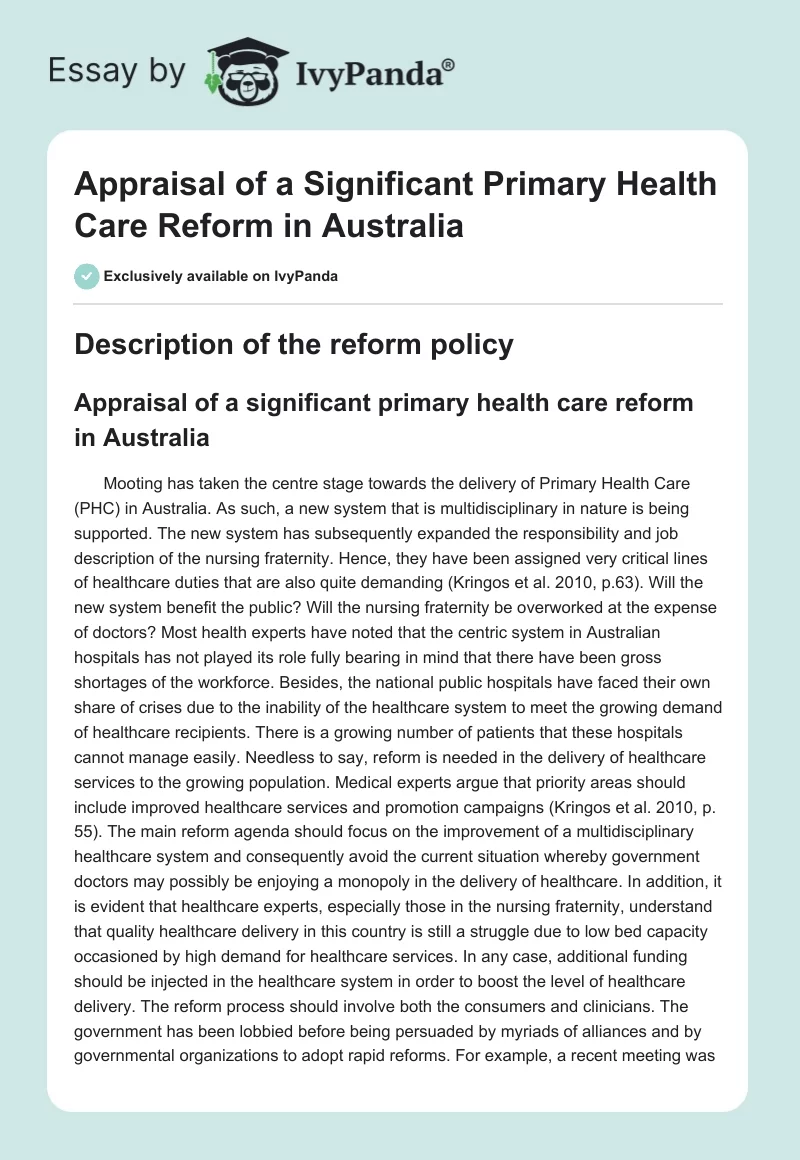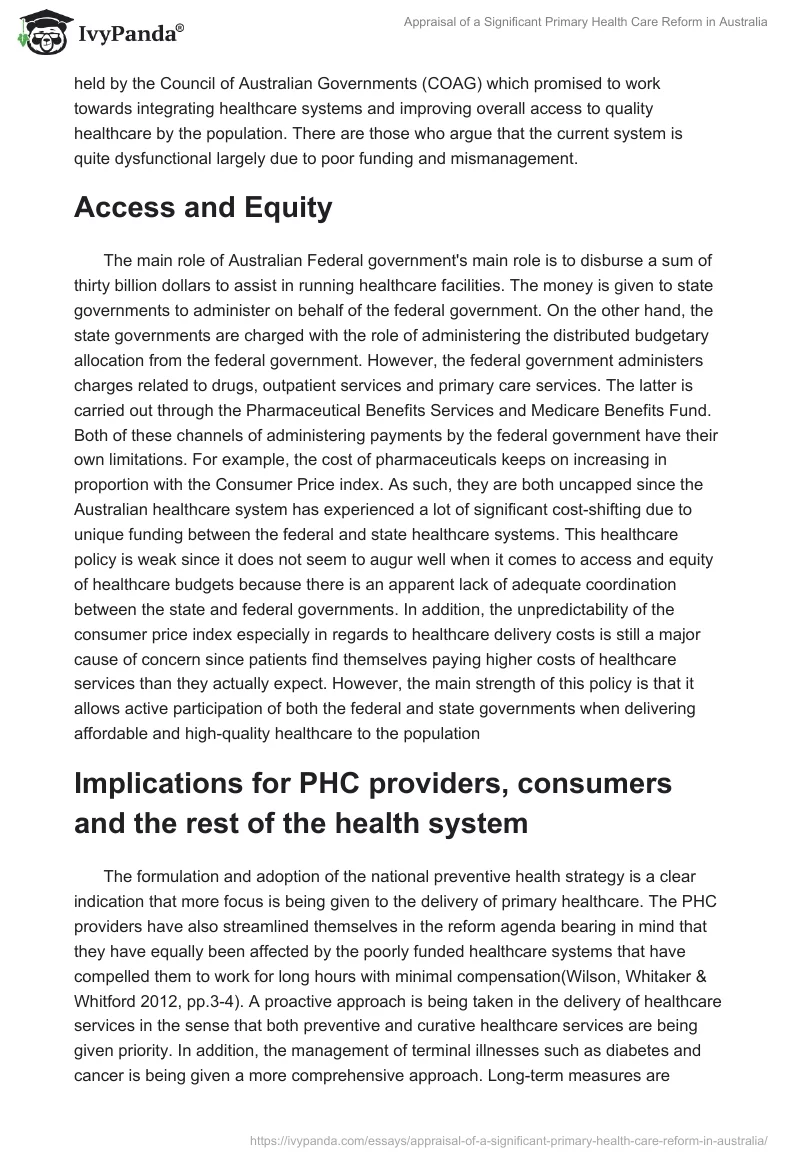Description of the reform policy
Appraisal of a significant primary health care reform in Australia
Mooting has taken the centre stage towards the delivery of Primary Health Care (PHC) in Australia. As such, a new system that is multidisciplinary in nature is being supported. The new system has subsequently expanded the responsibility and job description of the nursing fraternity. Hence, they have been assigned very critical lines of healthcare duties that are also quite demanding (Kringos et al. 2010, p.63). Will the new system benefit the public? Will the nursing fraternity be overworked at the expense of doctors? Most health experts have noted that the centric system in Australian hospitals has not played its role fully bearing in mind that there have been gross shortages of the workforce. Besides, the national public hospitals have faced their own share of crises due to the inability of the healthcare system to meet the growing demand of healthcare recipients. There is a growing number of patients that these hospitals cannot manage easily. Needless to say, reform is needed in the delivery of healthcare services to the growing population. Medical experts argue that priority areas should include improved healthcare services and promotion campaigns (Kringos et al. 2010, p. 55). The main reform agenda should focus on the improvement of a multidisciplinary healthcare system and consequently avoid the current situation whereby government doctors may possibly be enjoying a monopoly in the delivery of healthcare. In addition, it is evident that healthcare experts, especially those in the nursing fraternity, understand that quality healthcare delivery in this country is still a struggle due to low bed capacity occasioned by high demand for healthcare services. In any case, additional funding should be injected in the healthcare system in order to boost the level of healthcare delivery. The reform process should involve both the consumers and clinicians. The government has been lobbied before being persuaded by myriads of alliances and by governmental organizations to adopt rapid reforms. For example, a recent meeting was held by the Council of Australian Governments (COAG) which promised to work towards integrating healthcare systems and improving overall access to quality healthcare by the population. There are those who argue that the current system is quite dysfunctional largely due to poor funding and mismanagement.
Access and Equity
The main role of Australian Federal government’s main role is to disburse a sum of thirty billion dollars to assist in running healthcare facilities. The money is given to state governments to administer on behalf of the federal government. On the other hand, the state governments are charged with the role of administering the distributed budgetary allocation from the federal government. However, the federal government administers charges related to drugs, outpatient services and primary care services. The latter is carried out through the Pharmaceutical Benefits Services and Medicare Benefits Fund. Both of these channels of administering payments by the federal government have their own limitations. For example, the cost of pharmaceuticals keeps on increasing in proportion with the Consumer Price index. As such, they are both uncapped since the Australian healthcare system has experienced a lot of significant cost-shifting due to unique funding between the federal and state healthcare systems. This healthcare policy is weak since it does not seem to augur well when it comes to access and equity of healthcare budgets because there is an apparent lack of adequate coordination between the state and federal governments. In addition, the unpredictability of the consumer price index especially in regards to healthcare delivery costs is still a major cause of concern since patients find themselves paying higher costs of healthcare services than they actually expect. However, the main strength of this policy is that it allows active participation of both the federal and state governments when delivering affordable and high-quality healthcare to the population
Implications for PHC providers, consumers and the rest of the health system
The formulation and adoption of the national preventive health strategy is a clear indication that more focus is being given to the delivery of primary healthcare. The PHC providers have also streamlined themselves in the reform agenda bearing in mind that they have equally been affected by the poorly funded healthcare systems that have compelled them to work for long hours with minimal compensation(Wilson, Whitaker & Whitford 2012, pp.3-4). A proactive approach is being taken in the delivery of healthcare services in the sense that both preventive and curative healthcare services are being given priority. In addition, the management of terminal illnesses such as diabetes and cancer is being given a more comprehensive approach. Long-term measures are needed in order to provide the much-needed healthcare services to patients in a consistent manner. The primary healthcare providers are also supposed to be offered decent work incentives so that they can be more productive than the way they have been in the past. According to the healthcare reform proposals that are being championed by both the private and public sector, healthcare checks such as screening of ‘healthy’ individuals should be given adequate emphasis as part and parcel of preventive healthcare. The entire healthcare system is expected to benefit greatly because the $220 million project targeting healthcare establishments will be a major boost towards face-lifting the status of healthcare delivery in Australia. , The project is aiming at setting up GP super-clinics that will serve the healthcare needs of both the local and incoming visitors in various communities. It will have healthcare professionals such as physiotherapists, dieticians, podiatrists, nurses, and doctors stationed in one place making it easier for patients to access healthcare professionals
Regional and rural areas are likely to benefit from the first super clinics that were promised by the (federal/) government. Several areas that lack adequate healthcare professionals have been earmarked for the multi-million projects. The implication for the Australian healthcare system is that better health outcomes will be achieved with the improvement of the primary healthcare systems. This will result in greater equity and low mortality rates. In any case, a healthcare system that is focusing on hospitals per se is less likely to achieve the aforementioned benefits. One of the categories of healthcare professionals that will experience positive implications is the nursing fraternity (Mak et al. 2011, p.67). For a long time now, this group of professionals has been compelled to underperform their duties since they lack accessibility to pharmaceutical benefits schemes. Their main duties have entailed giving referral notes to patients, ordering diagnostics and prescribing therapies. It is pertinent to note that nurses can perform myriads of healthcare roles beyond what they have been doing for a relatively long period of time. There are several improved policy frameworks that the UK nurses benefit from compared to the case of nurses in Australia. Australian nurses are quite aware of these differences. This implies that they are hardly motivated to offer their services because they clearly understand that their needs are still demanding.
Monitoring process
The current proposals have no clear guidelines on how the processor implementation of the policy frameworks will be monitored. Nonetheless, it is expected that the state and federal governments will work for hand in hand in order to create and improve the coordination of healthcare activities within the assigned areas. For example, budgetary allocation to the identified healthcare improvement projects remains the sole role of the federal government. When it comes to the administration of these funds, the state governments are mandated equitable and transparent use of the assigned monetary resources. Therefore, it is without a doubt that the monitoring process cannot be effective when carried out by either the federal and state governments because they are key players in the system. On the other hand, it is important to note that the consumers of healthcare plans, nongovernmental organizations, as well as technocrats appointed by the state and federal governments, can monitor their role in a more judicious manner than the state and federal governments themselves. Another vital performance measure that can be put in place is the creation of healthcare delivery benchmarks that must be met in specific areas. Such benchmarks can tackle healthcare areas such as preventive measures for chronic infections, counseling patients, the proportion of the number of patients and nurses, doctors or other specialists, budgetary allocation and equitable distribution of available funds (MacIntyre 2011, p.39).
Recommendations
There is a need to teach healthcare professionals how to deal with critical appraisal skills. It is, rather, vital to put in place systems that have already been prepared that can allow these professionals to get prompt access to the much-needed information. Healthcare systems in Australia should not rely on passive data that is not updated. Therefore, it is highly recommended for policymakers to make use of updated information so that relevant decisions can be made. Decisions should be informed based on authenticated data obtained from patients and other healthcare centers.
Secondly, there is a need to set up effective performance measures or monitoring tools so that the work being done as recommended by these policies can be evaluated on a regular basis. This is necessary since there are some implementation processes that may be executed in the wrong way and consequently lead to poor results. As it stands now, the reform agenda in the Australian healthcare system has attempted to establish other unique and vibrant divisions (Donato & Segal 2010, p.615). It is pertinent to note that such divisions may fail to deliver as per the expectations of the policymakers in healthcare. Therefore, the General Practice Evaluation program should be used in order to provide the starting point where thorough evaluator processes can be launched. On the same note, guidance for the myriads of reform activities demands high levels of professionalism. Although the state and federal governments have played this role for several decades, a change process cannot be complete or successful without the inclusion of experienced professionals who can fully appraise the healthcare system.
References
Donato, R. & Segal, L 2010, “The economics of primary healthcare reform in Australia – towards single fundholding through the development of primary care organizations”. Australian and New Zealand Journal of Public Health, Vol. 34 no. 6, pp. 613-619
Kringos, DS et al. 2010, “The breadth of primary care: a systematic literature review of its core dimensions”. BMC Health Services Research, vol. 10 no. 65, pp. 50-76.
MacIntyre, RC 2011, “Public health and health reform in Australia”. Med J Aust, vol. 194 no. 1, pp. 38-40
Mak, S.L et al. 2011, “Pharmacists’ awareness of Australia’s health care reforms and their beliefs and attitudes about their current and future roles” International Journal of Pharmacy Practice, Vol. 20 no. 1, pp. 67-70.
Wilson, A., Whitaker, N. & Whitford, D 2012, “Rising to the Challenge of Health Care Reform With Entrepreneurial and Intrapreneurial Nursing Initiatives”.The Online Journal of Issues in Nursing, vol. 17 no. 2, pp. 1-5. Web.


